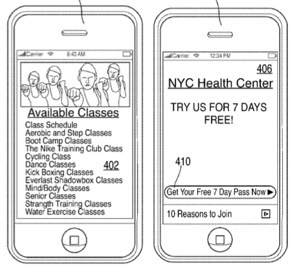A new Apple patent (number 20110098156) at the US Patent & Trademark Office shows that Apple is working on a new fitness app.
The patent is entitled "Systems and Methods for Accessing Personalized Fitness Services Using a Portable Electronic Device." It's directed to systems and methods for accessing personalized fitness services through an integrated application available to a portable electronic device.
Apple says the integrated application can provide a full fitness center experience by introducing potential new customer to a fitness center and then motivating them to return to the fitness center as active members. For example, the integrated application can provide functions to introduce new customers to a fitness center, can provide functions to motivate customers to join and actively visit the fitness center, can provide in-gym motivation, and can provide post-workout motivation. Stanley Carl Ng and Michael Hailey are the inventors.
Here's Apple's background and summary of the invention: "The benefits of exercise and healthy living are well-known in present day society. To this end, it is not uncommon for people to aspire to regularly workout or go to a fitness center. However, despite a person's good intentions or his desire to workout, a person may not achieve their goal amount of exercise. For example, busy schedules, not knowing how to properly use gym equipment, or other factors can cause a person to lack the motivation to go to a fitness center and workout.
"To help become motivated to regularly visit a fitness center, people often resort to techniques such as finding a workout buddy, scheduling sessions with a fitness trainer, attending workout classes, and the like. However, although these approaches for becoming motivated can be serviceable, they remain disjointed, lack a central hub, and may still result in the person losing motivation (e.g., the person may nonetheless cancel a training session, or tell a workout buddy they are not going to the fitness center today). Moreover, these approaches require a fitness center to accommodate all of the possible forms of interaction with the member of the fitness center (e.g., a member may need to call the fitness center to schedule a training session, go to the fitness center in person to get a spot in a class, and the like).
"From a member's perspective, the lack of centralization of interactions with the fitness center can require more effort from the member than he is willing to expend, and perhaps even dissuade the member from going to the fitness center. Not only may this adversely affect the member (e.g., the member may lose motivation and may not meet their workout goals), but this may also adversely affect the fitness provider as an un-motivated member may be more likely to cancel their membership (e.g., thus causing the fitness center to lose income).
"This is directed to systems and methods for accessing personalized fitness services using a portable electronic devices. An electronic device may include a single, seamless application to introduce new customers to a fitness center and motivate these new customers to keep returning to the fitness center as active members. In some embodiments, the integrated application can be provided on a portable electronic device such as a cellular phone, a laptop, a portable media player, or other suitable electronic device.
"To interface with a fitness center, the integrated application can, for example, securely connect to one or more servers associated with the fitness center. For example, the integrated application can connect with distinct servers associated with scheduling training sessions, accessing gym equipment guides, mapping directions to the fitness center, paying membership fees, communicated with exercise equipment of the fitness center, or any other suitable servers.
"In some embodiments, the integrated application can provide functions to introduce potential new customers to a fitness center. For example, the integrated application can showcase available classes and service of the fitness provider, provide fitness center locators, provide free passes to the fitness center, provide other promotions, provide affiliate offers, and any combination of the above.
"In some embodiments, the integrated application can provide functions to motivate a customer to join the fitness center (e.g., after the customer has been introduced to the fitness center) and actively attend the fitness center. For example, the integrated application can provide the user with news and updates associated with the fitness center, can provide daily promotions, can provide a scheduler (e.g., to allow a user to schedule session with a fitness trainer, to schedule classes, and the like), can provide social networking features (e.g., to help a user find a workout buddy, and any combination of the above).
"In some embodiments, the integrated application can provide in-gym motivation. For example, the integrated application can allow a user to access equipment guides, can allow a user to access workout videos, can track a user's workout routine in real-time (e.g., display on a screen of a portable electronic device the treadmill's speed, the amount of weight being used on a piece of exercise equipment, and the like), can promote competition among members of the fitness center (e.g., thus motivating fitness center members to “beat one another's scores” and workout harder), and any combination of the above.
"In some embodiments, the integrated application can provide post-workout motivation. For example, the integrated application can provide a user with coupons that may help a user re-energize (e.g., power drink coupons, spa coupons, and the like), can provide reminders prompting a user to return to the fitness center, can provide up-sell opportunities (e.g., by selling a music playlist from a class the user took), can provide analytical tools for analyzing a user's past workout information, and any combination of the above."
-- Dennis Sellers














